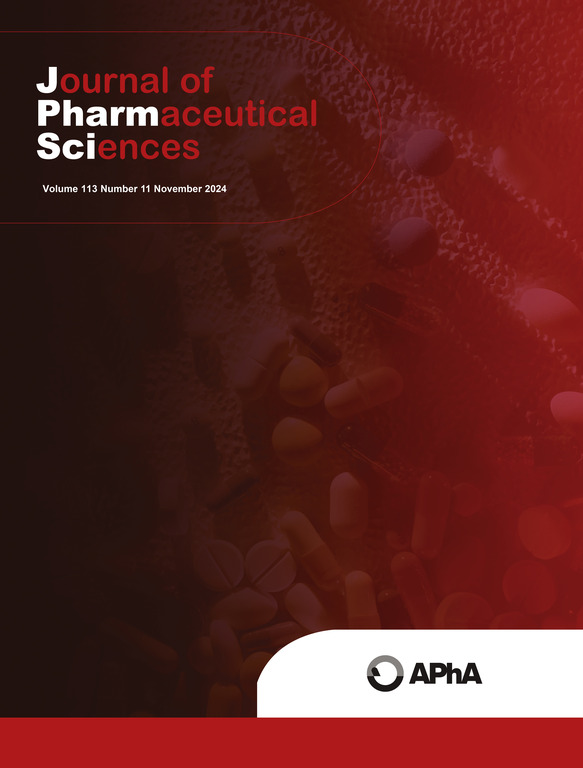Investigating the effects of formulation variables on the disintegration of spray dried amorphous solid dispersion tablets
IF 3.8
3区 医学
Q2 CHEMISTRY, MEDICINAL
引用次数: 0
Abstract
Amorphous solid dispersion (ASD) tablets based on hydrophilic polymer carriers may encounter disintegration challenges. In this work, the effect of different formulation composition variables on the ASD tablet disintegration performance was systematically studied. GDC-0334: copovidone (PVPVA) 60: 40 ASD prepared by spray drying was selected as the model ASD system. The effects of ASD loading, filler type and ratio, disintegrant type and level were then investigated using tablets made by direct compression process. Tablet disintegration time increased with the increase of ASD loading, especially when ASD loading exceeded 50 %. At the same tablet solid fraction, when lactose was used as the soluble filler, faster tablet disintegration was observed compared to the tablets with mannitol as the soluble filler. Among the three tested disintegrants, croscarmellose sodium performed the best in facilitating the ASD tablet disintegration, followed by sodium starch glycolate, and crospovidone was the poorest. When croscarmellose sodium was used as the disintegrant, 5 % level was sufficient to enable ASD tablet disintegration at 60 % ASD loading and further increase of croscarmellose sodium level to 8 % did not provide additional benefit. Water uptake experiments were performed on selected tablets and the results demonstrated a positive correlation with tablet disintegration time, indicating water penetration is a major contributing step for the disintegration of our ASD tablets. Overall, this work provides a rationale for excipient selection and insights into building a platform formulation approach for developing immediate-release ASD tablets.

研究配方变量对喷雾干燥无定形固体分散片崩解性的影响
基于亲水性聚合物载体的无定形固体分散片(ASD)可能会遇到崩解难题。在这项工作中,我们系统地研究了不同配方组成变量对 ASD 片剂崩解性能的影响。选择喷雾干燥法制备的 GDC-0334: copovidone (PVPVA) 60: 40 ASD 作为 ASD 体系模型。然后使用直接压片工艺研究了 ASD 负载量、填料类型和比例、崩解剂类型和含量的影响。片剂崩解时间随 ASD 含量的增加而延长,尤其是当 ASD 含量超过 50%时。在相同的片剂固体分数下,以乳糖作为可溶性填料时,与以甘露醇作为可溶性填料的片剂相比,片剂崩解时间更快。在三种测试的崩解剂中,在促进 ASD 片剂崩解方面,croscarmellose sodium 的表现最好,其次是淀粉乙醇酸钠,而 crospovidone 的表现最差。当使用氨甲环酸钙钠作为崩解剂时,5% 的含量足以使 ASD 片剂在 ASD 含量为 60% 时崩解,而将氨甲环酸钙钠的含量进一步提高到 8%,也不会带来额外的益处。对选定的片剂进行了吸水实验,结果表明吸水与片剂崩解时间呈正相关,表明水的渗透是促进 ASD 片剂崩解的一个主要步骤。总之,这项研究为辅料的选择提供了理论依据,并为开发速释 ASD 片剂的平台制剂方法提供了启示。
本文章由计算机程序翻译,如有差异,请以英文原文为准。
求助全文
约1分钟内获得全文
求助全文
来源期刊
CiteScore
7.30
自引率
13.20%
发文量
367
审稿时长
33 days
期刊介绍:
The Journal of Pharmaceutical Sciences will publish original research papers, original research notes, invited topical reviews (including Minireviews), and editorial commentary and news. The area of focus shall be concepts in basic pharmaceutical science and such topics as chemical processing of pharmaceuticals, including crystallization, lyophilization, chemical stability of drugs, pharmacokinetics, biopharmaceutics, pharmacodynamics, pro-drug developments, metabolic disposition of bioactive agents, dosage form design, protein-peptide chemistry and biotechnology specifically as these relate to pharmaceutical technology, and targeted drug delivery.

 求助内容:
求助内容: 应助结果提醒方式:
应助结果提醒方式:


